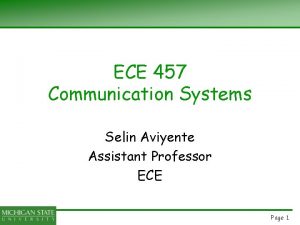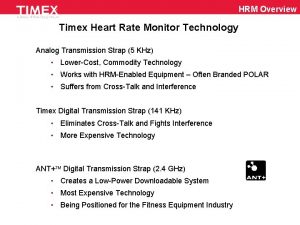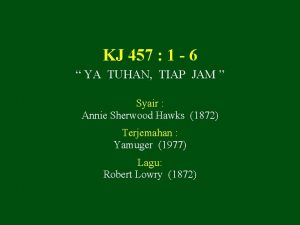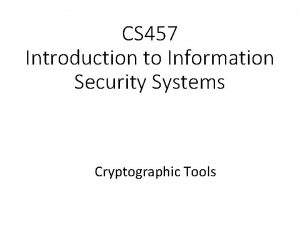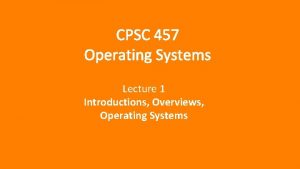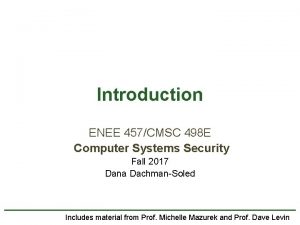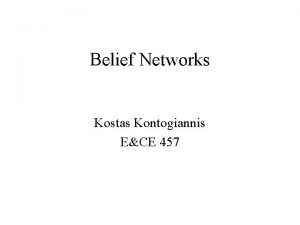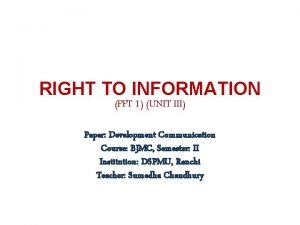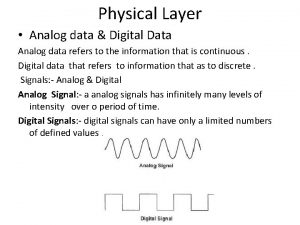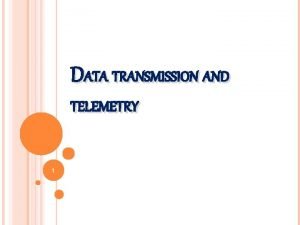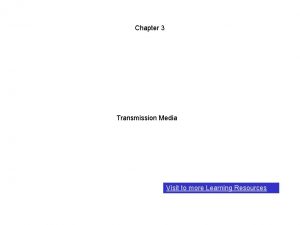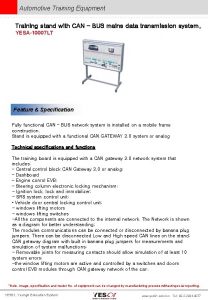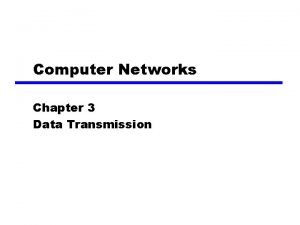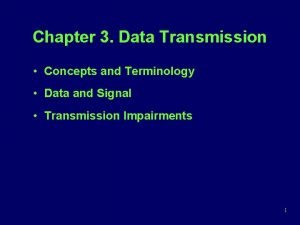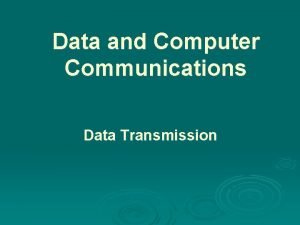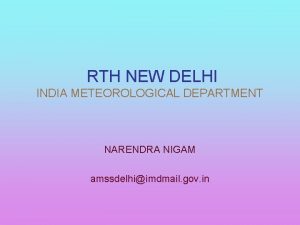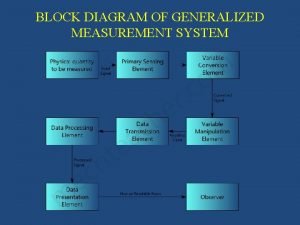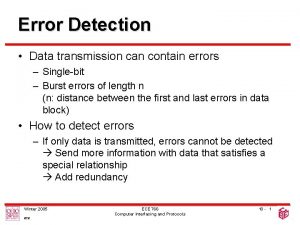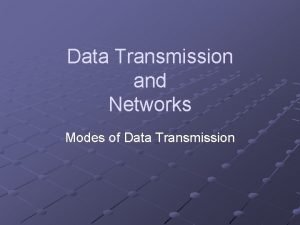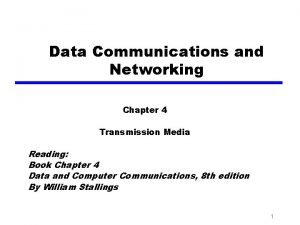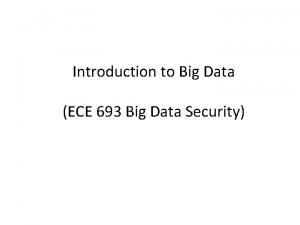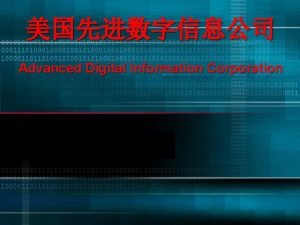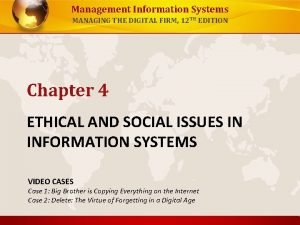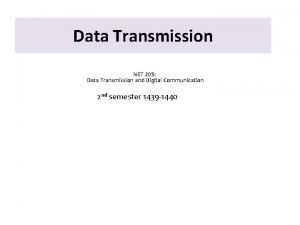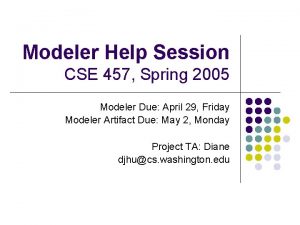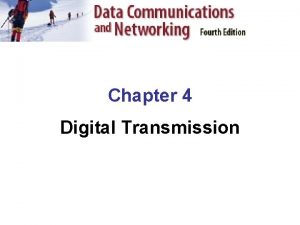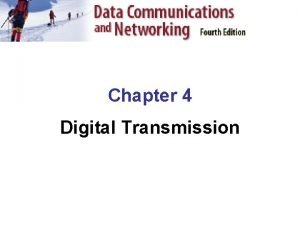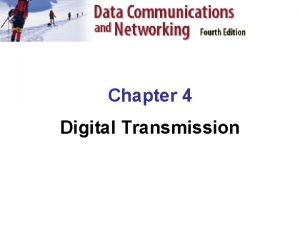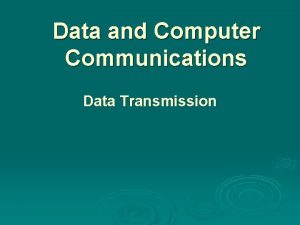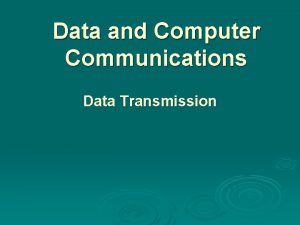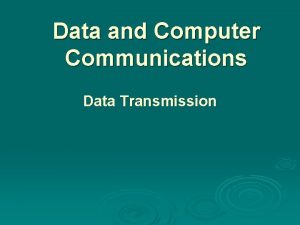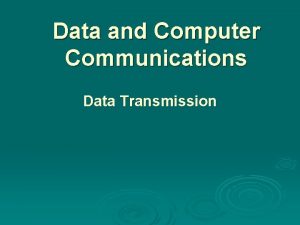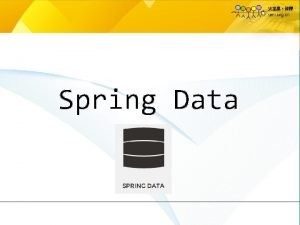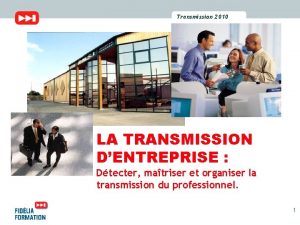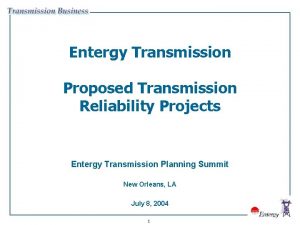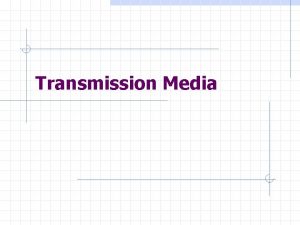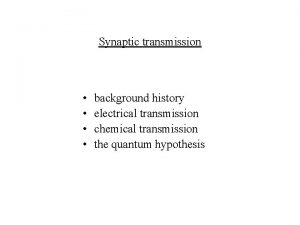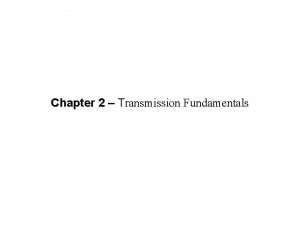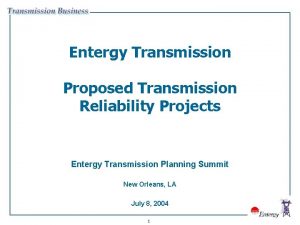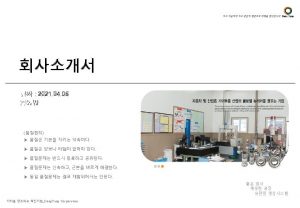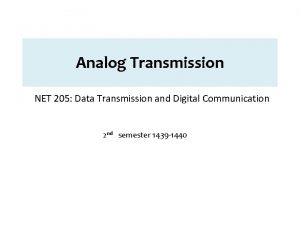Digital Data Transmission ECE 457 Spring 2005 Information













































- Slides: 45

Digital Data Transmission ECE 457 Spring 2005


Information Representation • Communication systems convert information into a form suitable for transmission • Analog systems Analog signals are modulated (AM, FM radio) • Digital system generate bits and transmit digital signals (Computers) • Analog signals can be converted to digital signals.

Digital Data System

Components of Digital Communication • Sampling: If the message is analog, it’s converted to discrete time by sampling. (What should the sampling rate be ? ) • Quantization: Quantized in amplitude. Discrete in time and amplitude • Encoder: – Convert message or signals in accordance with a set of rules – Translate the discrete set of sample values to a signal. • Decoder: Decodes received signals back into original message

Different Codes

Performance Metrics • In analog communications we want, • Digital communication systems: – – Data rate (R bps) (Limited) Channel Capacity Probability of error Without noise, we don’t make bit errors Bit Error Rate (BER): Number of bit errors that occur for a given number of bits transmitted. • What’s BER if Pe=10 -6 and 107 bits are transmitted?

Advantages • Stability of components: Analog hardware change due to component aging, heat, etc. • Flexibility: – Perform encryption – Compression – Error correction/detection • Reliable reproduction

Applications • Digital Audio Transmission • Telephone channels • Lowpass filter, sample, quantize • 32 kbps-64 kbps (depending on the encoder) • Digital Audio Recording • LP vs. CD • Improve fidelity (How? ) • More durable and don’t deteriorate with time

Baseband Data Transmission

• Each T-second pulse is a bit. • Receiver has to decide whether it’s a 1 or 0 ( A or –A) • Integrate-and-dump detector • Possible different signaling schemes?

Receiver Structure

Receiver Preformance • The output of the integrator: • is a random variable. • N is Gaussian. Why?

Analysis • Key Point – White noise is uncorrelated

Error Analysis • Therefore, the pdf of N is: • In how many different ways, can an error occur?

Error Analysis • Two ways in which errors occur: – A is transmitted, AT+N<0 (0 received, 1 sent) – -A is transmitted, -AT+N>0 (1 received, 0 sent)

• • Similarly, • The average probability of error:

• Energy per bit: • Therefore, the error can be written in terms of the energy. • Define

• Recall: Rectangular pulse of duration T seconds has magnitude spectrum • Effective Bandwidth: • Therefore, • What’s the physical meaning of this quantity?

Probability of Error vs. SNR

Error Approximation • Use the approximation

Example • Digital data is transmitted through a baseband system with , the received pulse amplitude A=20 m. V. a)If 1 kbps is the transmission rate, what is probability of error?

b) If 10 kbps are transmitted, what must be the value of A to attain the same probability of error? • Conclusion: Transmission power vs. Bit rate

Binary Signaling Techniques


Amplitude Shift Keying (ASK) • 0 0 • 1 Acos(wct) • What is the structure of the optimum receiver?

Receiver for binary signals in noise

Error Analysis • 0 s 1(t), 1 s 2(t) in general. • The received signal: • Noise is white and Gaussian. • Find PE • In how many different ways can an error occur?

Error Analysis (general case) • Two ways for error: » Receive 1 Send 0 » Receive 0 Send 1 • Decision: » The received signal is filtered. (How does this compare to baseband transmission? ) » Filter output is sampled every T seconds » Threshold k » Error occurs when:

• are filtered signal and noise terms. • Noise term: is the filtered white Gaussian noise. • Therefore, it’s Gaussian (why? ) • Has PSD: • Mean zero, variance? • Recall: Variance is equal to average power of the noise process

• The pdf of noise term is: • Note that we still don’t know what the filter is. • Will any filter work? Or is there an optimal one? • Recall that in baseband case (no modulation), we had the integrator which is equivalent to filtering with

• The input to the thresholder is: • These are also Gaussian random variables; why? • Mean: • Variance: Same as the variance of N

Distribution of V • The distribution of V, the input to the threshold device is:

Probability of Error • Two types of errors: • The average probability of error:

• Goal: Minimize the average probability of errror • Choose the optimal threshold • What should the optimal threshold, kopt be? • Kopt=0. 5[s 01(T)+s 02(T)] •

Observations • PE is a function of the difference between the two signals. • Recall: Q-function decreases with increasing argument. (Why? ) • Therefore, PE will decrease with increasing distance between the two output signals • Should choose the filter h(t) such that PE is a minimum maximize the difference between the two signals at the output of the filter

Matched Filter • Goal: Given , choose H(f) such that is maximized. • The solution to this problem is known as the matched filter and is given by: • Therefore, the optimum filter depends on the input signals.

Matched filter receiver

Error Probability for Matched Filter Receiver • Recall • The maximum value of the distance, • E 1 is the energy of the first signal. • E 2 is the energy of the second signal.

• Therefore, • Probability of error depends on the signal energies (just as in baseband case), noise power, and the similarity between the signals. • If we make the transmitted signals as dissimilar as possible, then the probability of error will decrease ( )

ASK • • The matched filter: Optimum Threshold: Similarity between signals? Therefore, • 3 d. B worse than baseband.

PSK • Modulation index: m (determines the phase jump) • Matched Filter: • Threshold: 0 • Therefore, • For m=0, 3 d. B better than ASK.

Matched Filter for PSK

FSK • • • Probability of Error: • Same as ASK

Applications • Modems: FSK • RF based security and access control systems • Cellular phones
 Ece 457
Ece 457 Data encoding and transmission
Data encoding and transmission Timex ironman hrm
Timex ironman hrm Spring, summer, fall, winter... and spring (2003)
Spring, summer, fall, winter... and spring (2003) Fall spring summer winter
Fall spring summer winter 888-457-5851
888-457-5851 457 1
457 1 Cs 457
Cs 457 Cpsc 457
Cpsc 457 Tcg group holdings
Tcg group holdings Cmsc 457
Cmsc 457 Artaxerxes decree 457
Artaxerxes decree 457 Cpsc 457
Cpsc 457 Digital data digital signals
Digital data digital signals Data encoding techniques
Data encoding techniques Disadvantages of pulse amplitude modulation
Disadvantages of pulse amplitude modulation Analogue and digital transmission
Analogue and digital transmission Analog and digital signals in computer networking
Analog and digital signals in computer networking Disability act 2005 citizens information
Disability act 2005 citizens information Right to information ppt
Right to information ppt Sys.sp_cdc_change_job
Sys.sp_cdc_change_job Analog data and digital data
Analog data and digital data Spring information systems
Spring information systems Voltage and current telemetry system
Voltage and current telemetry system Transmission media in data communication
Transmission media in data communication Automobile data transmission system can bus training stand
Automobile data transmission system can bus training stand ñ meaning
ñ meaning Baseband binary data transmission system
Baseband binary data transmission system Transmission terminology
Transmission terminology Transmission terminology
Transmission terminology Amss chennai data transmission
Amss chennai data transmission Block diagram measurement system
Block diagram measurement system Vertical redundancy check
Vertical redundancy check Parallel transmission mode
Parallel transmission mode Transmission medias
Transmission medias Ece big data
Ece big data Apa pengertian dari warga digital
Apa pengertian dari warga digital Digital markets and digital goods
Digital markets and digital goods E-commerce: digital markets, digital goods
E-commerce: digital markets, digital goods Luxinnovation logo
Luxinnovation logo E-commerce digital markets digital goods
E-commerce digital markets digital goods Digital services for information management
Digital services for information management Advanced digital information corporation
Advanced digital information corporation Management information system managing the digital firm
Management information system managing the digital firm What is mil subject
What is mil subject Management information systems managing the digital firm
Management information systems managing the digital firm
